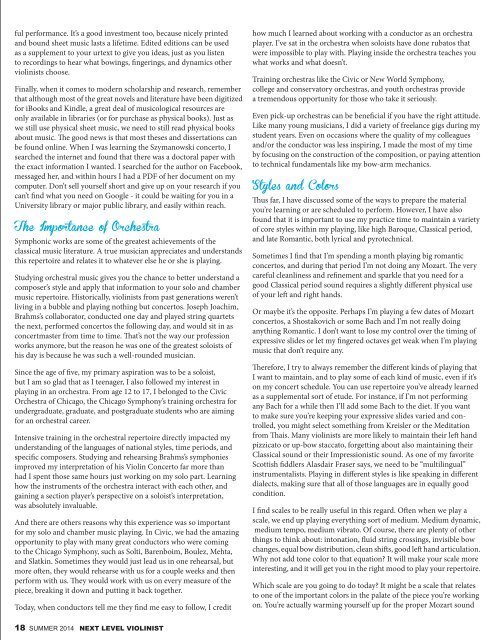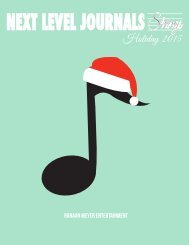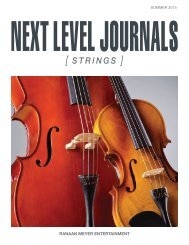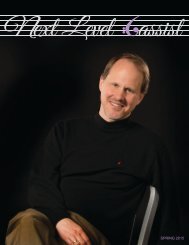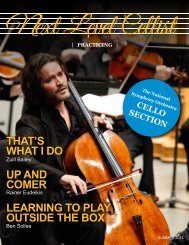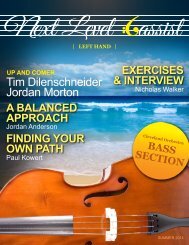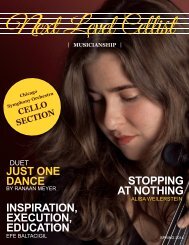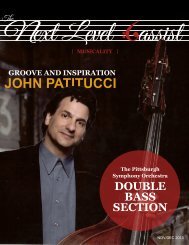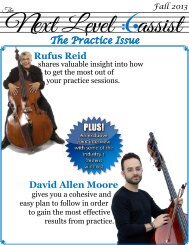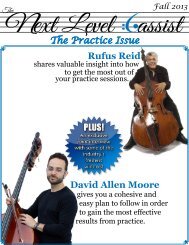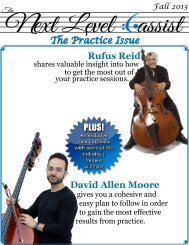Next Level Violinist Practicing Issue
The Summer issue of Next Level Violinist, the free online journal for violinists of all levels and ages. Featuring articles and interviews by Alex Kerr, Rachel Barton Pine, and Eunice Kim. Visit www.nextleveljournals.com to become a member.
The Summer issue of Next Level Violinist, the free online journal for violinists of all levels and ages. Featuring articles and interviews by Alex Kerr, Rachel Barton Pine, and Eunice Kim. Visit www.nextleveljournals.com to become a member.
Create successful ePaper yourself
Turn your PDF publications into a flip-book with our unique Google optimized e-Paper software.
ful performance. It’s a good investment too, because nicely printed<br />
and bound sheet music lasts a lifetime. Edited editions can be used<br />
as a supplement to your urtext to give you ideas, just as you listen<br />
to recordings to hear what bowings, fingerings, and dynamics other<br />
violinists choose.<br />
Finally, when it comes to modern scholarship and research, remember<br />
that although most of the great novels and literature have been digitized<br />
for iBooks and Kindle, a great deal of musicological resources are<br />
only available in libraries (or for purchase as physical books). Just as<br />
we still use physical sheet music, we need to still read physical books<br />
about music. The good news is that most theses and dissertations can<br />
be found online. When I was learning the Szymanowski concerto, I<br />
searched the internet and found that there was a doctoral paper with<br />
the exact information I wanted. I searched for the author on Facebook,<br />
messaged her, and within hours I had a PDF of her document on my<br />
computer. Don’t sell yourself short and give up on your research if you<br />
can’t find what you need on Google - it could be waiting for you in a<br />
University library or major public library, and easily within reach.<br />
<br />
Symphonic works are some of the greatest achievements of the<br />
classical music literature. A true musician appreciates and understands<br />
this repertoire and relates it to whatever else he or she is playing.<br />
Studying orchestral music gives you the chance to better understand a<br />
composer’s style and apply that information to your solo and chamber<br />
music repertoire. Historically, violinists from past generations weren’t<br />
living in a bubble and playing nothing but concertos. Joseph Joachim,<br />
Brahms’s collaborator, conducted one day and played string quartets<br />
the next, performed concertos the following day, and would sit in as<br />
concertmaster from time to time. That’s not the way our profession<br />
works anymore, but the reason he was one of the greatest soloists of<br />
his day is because he was such a well-rounded musician.<br />
Since the age of five, my primary aspiration was to be a soloist,<br />
but I am so glad that as I teenager, I also followed my interest in<br />
playing in an orchestra. From age 12 to 17, I belonged to the Civic<br />
Orchestra of Chicago, the Chicago Symphony’s training orchestra for<br />
undergraduate, graduate, and postgraduate students who are aiming<br />
for an orchestral career.<br />
Intensive training in the orchestral repertoire directly impacted my<br />
understanding of the languages of national styles, time periods, and<br />
specific composers. Studying and rehearsing Brahms’s symphonies<br />
improved my interpretation of his Violin Concerto far more than<br />
had I spent those same hours just working on my solo part. Learning<br />
how the instruments of the orchestra interact with each other, and<br />
gaining a section player’s perspective on a soloist’s interpretation,<br />
was absolutely invaluable.<br />
And there are others reasons why this experience was so important<br />
for my solo and chamber music playing. In Civic, we had the amazing<br />
opportunity to play with many great conductors who were coming<br />
to the Chicago Symphony, such as Solti, Barenboim, Boulez, Mehta,<br />
and Slatkin. Sometimes they would just lead us in one rehearsal, but<br />
more often, they would rehearse with us for a couple weeks and then<br />
perform with us. They would work with us on every measure of the<br />
piece, breaking it down and putting it back together.<br />
Today, when conductors tell me they find me easy to follow, I credit<br />
how much I learned about working with a conductor as an orchestra<br />
player. I’ve sat in the orchestra when soloists have done rubatos that<br />
were impossible to play with. Playing inside the orchestra teaches you<br />
what works and what doesn’t.<br />
Training orchestras like the Civic or New World Symphony,<br />
college and conservatory orchestras, and youth orchestras provide<br />
a tremendous opportunity for those who take it seriously.<br />
Even pick-up orchestras can be beneficial if you have the right attitude.<br />
Like many young musicians, I did a variety of freelance gigs during my<br />
student years. Even on occasions where the quality of my colleagues<br />
and/or the conductor was less inspiring, I made the most of my time<br />
by focusing on the construction of the composition, or paying attention<br />
to technical fundamentals like my bow-arm mechanics.<br />
<br />
Thus far, I have discussed some of the ways to prepare the material<br />
you’re learning or are scheduled to perform. However, I have also<br />
found that it is important to use my practice time to maintain a variety<br />
of core styles within my playing, like high Baroque, Classical period,<br />
and late Romantic, both lyrical and pyrotechnical.<br />
Sometimes I find that I’m spending a month playing big romantic<br />
concertos, and during that period I’m not doing any Mozart. The very<br />
careful cleanliness and refinement and sparkle that you need for a<br />
good Classical period sound requires a slightly different physical use<br />
of your left and right hands.<br />
Or maybe it’s the opposite. Perhaps I’m playing a few dates of Mozart<br />
concertos, a Shostakovich or some Bach and I’m not really doing<br />
anything Romantic. I don’t want to lose my control over the timing of<br />
expressive slides or let my fingered octaves get weak when I’m playing<br />
music that don’t require any.<br />
Therefore, I try to always remember the different kinds of playing that<br />
I want to maintain, and to play some of each kind of music, even if it’s<br />
on my concert schedule. You can use repertoire you’ve already learned<br />
as a supplemental sort of etude. For instance, if I’m not performing<br />
any Bach for a while then I’ll add some Bach to the diet. If you want<br />
to make sure you’re keeping your expressive slides varied and controlled,<br />
you might select something from Kreisler or the Meditation<br />
from Thais. Many violinists are more likely to maintain their left hand<br />
pizzicato or up-bow staccato, forgetting about also maintaining their<br />
Classical sound or their Impressionistic sound. As one of my favorite<br />
Scottish fiddlers Alasdair Fraser says, we need to be “multilingual”<br />
instrumentalists. Playing in different styles is like speaking in different<br />
dialects, making sure that all of those languages are in equally good<br />
condition.<br />
I find scales to be really useful in this regard. Often when we play a<br />
scale, we end up playing everything sort of medium. Medium dynamic,<br />
medium tempo, medium vibrato. Of course, there are plenty of other<br />
things to think about: intonation, fluid string crossings, invisible bow<br />
changes, equal bow distribution, clean shifts, good left hand articulation.<br />
Why not add tone color to that equation? It will make your scale more<br />
interesting, and it will get you in the right mood to play your repertoire.<br />
Which scale are you going to do today? It might be a scale that relates<br />
to one of the important colors in the palate of the piece you’re working<br />
on. You’re actually warming yourself up for the proper Mozart sound<br />
18 SUMMER 2014 NEXT LEVEL VIOLINIST


